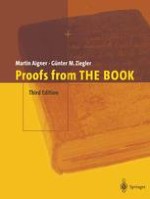2004 | OriginalPaper | Buchkapitel
Three applications of Euler’s formula
verfasst von : Martin Aigner, Günter M. Ziegler
Erschienen in: Proofs from THE BOOK
Verlag: Springer Berlin Heidelberg
Enthalten in: Professional Book Archive
Aktivieren Sie unsere intelligente Suche, um passende Fachinhalte oder Patente zu finden.
Wählen Sie Textabschnitte aus um mit Künstlicher Intelligenz passenden Patente zu finden. powered by
Markieren Sie Textabschnitte, um KI-gestützt weitere passende Inhalte zu finden. powered by
A graph is planar if it can be drawn in the plane ℝ2 without crossing edges (or, equivalently, on the 2-dimensional sphere S2). We talk of a plane graph if such a drawing is already given and fixed. Any such drawing decomposes the plane or sphere into a finite number of connected regions, including the outer (unbounded) region, which are referred to as faces. Euler’s formula exhibits a beautiful relation between the number of vertices, edges and faces that is valid for any plane graph. Euler mentioned this result for the first time in a letter to his friend Goldbach in 1750, but he did not have a complete proof at the time. Among the many proofs of Euler’s formula, we present a pretty and “self-dual” one that gets by without induction. It can be traced back to von Staudt’s book “Geometrie der Lage” from 1847.
